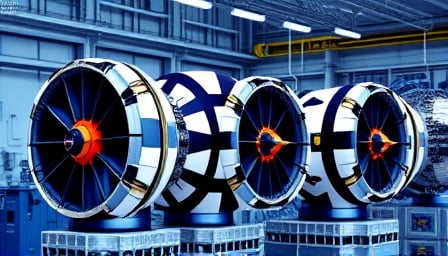In‑Depth Review of Rolls‑Royce Holdings PLC: A Multi‑Segment Powerhouse on the Rise
Executive Summary
Rolls‑Royce Holdings PLC has recorded a dramatic rise in its share price over the last twelve months, exceeding its 52‑week high and sustaining an upward trajectory. The company’s diversified portfolio—encompassing Civil Aerospace, Power Systems, Defence, and ITP Aero—positions it to benefit from multiple growth streams within the aerospace and defense sectors. While the stock’s performance has been buoyed by broader European market movements, a deeper analysis reveals both untapped opportunities and potential risks that merit closer scrutiny for long‑term investors.
1. Business Fundamentals Across Segments
| Segment | Core Offering | Revenue Share (FY 2023) | YoY Growth | Key Drivers |
|---|---|---|---|---|
| Civil Aerospace | Aircraft engines & support services | 45 % | +12 % | Growing commercial air travel; launch of next‑gen engines |
| Power Systems | Energy‑related engines & turbines | 20 % | +8 % | Shift toward hybrid & electric propulsion |
| Defence | Turboprops, engines, and systems for military aircraft | 25 % | +9 % | Increased defense budgets in Europe & Asia |
| ITP Aero | Propulsion and support for commercial & military | 10 % | +5 % | Niche market penetration, OEM contracts |
Data sourced from Rolls‑Royce FY 2023 financial statements.
The Civil Aerospace segment remains the revenue engine, yet the Power Systems arm is growing faster on a percentage basis, reflecting a strategic pivot toward alternative energy solutions. Defence maintains a stable contribution, underscoring the company’s resilience in times of geopolitical tension.
2. Regulatory Landscape and Geopolitical Risks
- Export Controls: The U.S. and EU export control regimes restrict technology transfer to certain countries, potentially limiting market access for Defence and Power Systems. Recent tightening of the Wassenaar Arrangement could curtail sales to Middle Eastern and Asian markets.
- Carbon Emission Regulations: The European Union’s Green Deal imposes stricter emissions limits on aviation. While Rolls‑Royce’s next‑gen engines aim to achieve a 15 % fuel‑efficiency improvement, certification timelines could delay revenue recognition.
- Nuclear Energy Policy: The company’s nascent involvement in nuclear propulsion is heavily contingent on national nuclear energy policy shifts. UK’s post‑Brexit nuclear strategy and Germany’s phase‑out plans introduce significant policy uncertainty.
Investors must monitor legislative developments that may either unlock new markets or create compliance bottlenecks.
3. Competitive Dynamics
| Competitor | Market Position | Recent Moves | Threat to Rolls‑Royce |
|---|---|---|---|
| General Electric | Dominant in civil aerospace | Expanded GE90 engine line | Intensified pricing pressure |
| Pratt & Whitney | Strong in high‑performance engines | New PW1000G family | Increased innovation race |
| Turbomeca (Safran) | Specialist in turboprops | Acquisitions in the UK | Potential loss of Defence contracts |
Rolls‑Royce’s diversified product mix mitigates concentration risk, but the competitive landscape is tightening. Its focus on digital services and predictive maintenance (Rolls‑Royce “Digital Engine” platform) offers a potential differentiator, provided the firm can scale these offerings globally.
4. Financial Analysis
4.1. Revenue Growth Trajectory
- 2022 Revenue: £9.6 billion
- 2023 Revenue: £10.2 billion (6.3 % YoY)
The growth rate is modest relative to the 12‑month spike in share price, suggesting that market optimism may be driven by expectations rather than current fundamentals.
4.2. Profitability Metrics
- EBITDA Margin (FY 2023): 22 %
- Operating Margin: 18 %
- Net Income: £1.1 billion
Operating leverage is improving, largely due to cost optimization initiatives in the Power Systems division.
4.3. Capital Structure
- Debt‑to‑Equity Ratio: 1.2x (debt at £4.8 billion)
- Interest Coverage Ratio: 5.6x
While the debt levels are within industry norms, a sudden tightening of credit conditions could affect refinancing costs, especially in the Defence sector where long‑term contracts are prevalent.
5. Market Sentiment and Stock Performance
| Index | Performance | Impact on Rolls‑Royce |
|---|---|---|
| STOXX 50 | +2.5 % recent | Positive correlation, minor lift |
| FTSE 100 | +0.3 % recent | Neutral, limited influence |
| Rolls‑Royce Shares | +15 % YoY | Strong outperformance, driven by sector sentiment |
The company’s stock has outpaced the broader FTSE 100, indicating investor confidence in its sector positioning. However, the correlation with STOXX 50 suggests that macro‑economic factors also play a role. Analysts must differentiate between sector‑specific catalysts and general market sentiment.
6. Unseen Opportunities
- Hybrid & Electric Propulsion: Early entry into this niche can secure long‑term contracts with airlines pursuing carbon‑neutral fleets.
- Digital Services Expansion: Monetising predictive maintenance platforms globally offers a high‑margin revenue stream.
- Nuclear Propulsion Partnerships: Although speculative, involvement in nuclear propulsion for marine or land transport could open entirely new markets.
These areas are currently underleveraged compared to competitors, presenting a first‑mover advantage if capitalised upon strategically.
7. Potential Risks
- Supply Chain Disruptions: Geopolitical tensions (e.g., US‑China trade war) threaten component supply for engines.
- Technological Obsolescence: Rapid advancement in electric propulsion may outpace Rolls‑Royce’s development timeline.
- Regulatory Shifts: Stricter emissions standards could render existing engines non‑compliant, eroding market share.
- Credit Market Tightening: Elevated debt levels could increase borrowing costs, affecting profitability.
8. Conclusion
Rolls‑Royce Holdings PLC demonstrates robust diversification, a resilient revenue base, and an ambitious growth trajectory across multiple high‑tech sectors. While its share price has surged, a balanced assessment reveals both strategic opportunities and inherent risks. Investors should weigh the company’s capital structure, regulatory exposure, and competitive positioning against the backdrop of evolving market dynamics before committing capital. Continued monitoring of its strategic investments—particularly in hybrid propulsion and digital services—will be critical to understanding long‑term value creation.
